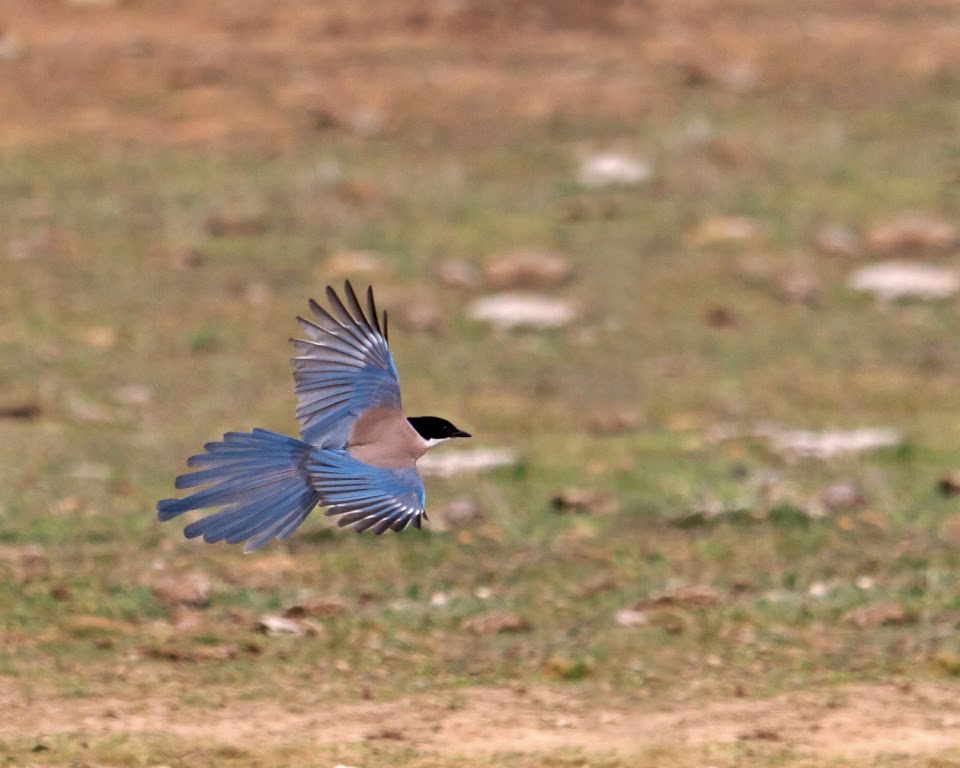 |
| Azure-winged Magpie (John Hawkins) |
There is symmetry, space and depth, a sense of expansive order. In the near distance, the shadows cast by the trees draw uniform dark bands across the sward. Each tree, individually different, but shaped by human hand through the cycles of pruning to offer a sense of managed nurturing, providing an architecture of form replicated a million times across the landscape.....for this open woodland stretches to the horizon and beyond. And even at the limits of our view, there is the stippling, the shapes of individual crowns. A swooping movement brings my focus back and accompanied by nasal calls a band of Azure-winged Magpies move between the trees, casting gentle arcs of motion, swinging in the same direction, to their communal roost.
 |
| Winter dehesa (Martin Kelsey) |
Nothing more typifies the Extremaduran landscape than the
dehesa. There is no neat English equivalent word for this habitat, and attempts to define it in anglicised form fail either in precision or elegance: I find
wood pasture helpful, and terms like
savanna offer a good sense of appearance, whilst "
agro-silvo-pastoral system" technically captures the farming practiced....and this open woodland is largely farmland (apart from thoses estates dedicated to hunting) and a traditional, low-intensity, integrated farming system at that. The word
dehesa has acquired its descriptive role for this landscape over time: it literally means "fenced pasture" or enclosure from the Latin
defensus ("fenced") and one can find farms and estates bearing the name
Dehesa in other landscapes too, such as the tree-less plains. But it is now the term widely used for the landscape across south-western Spain (in neighbouring Portugal the word
montado applies) dominated by holm oak (the
encinas), and where the micro-climate is more suitable, by cork oak.
Looking at the distribution map of the
dehesa landscape, it matches almost exactly the well defined limits of the Azure-winged Magpie too. This is a species closely associated with this evergreen oak habitat and highly sedentary, abundant within its range and wholly absent beyond. And remarkable too in its bizarre disjunct global distribution, with the
dehesa-linked pocket in the Iberian peninsula and then reappearing only again in the Asian Far East. DNA evidence shows that prior to glaciation the two populations were linked and over that the subsequent millenia genetic drift has pushed them into what many authorities now consider are separate species - making the Iberian Magpie a
dehesa endemic.
My thoughts moved to this landscape on hearing the news this month of the death of Oliver Rackham (see the Guardian
oliver-rackham obituary). I remember as a student being spellbound at a lecture he gave on ancient woodlands, his elegant interpretation of the living history of a tree and the intimacy between woodland and people. I took a group of students a few years ago to see the magnificent sweet chestnut tree near the town of Castañar del Ibor, which is estimated to be over 700 years old. I asked each of the 20 students to collect 35 sweet chestnuts from the ground and we placed them in a long line, all 700 of them, making the lifetime of this tree. At points along the file we could make landmarks in human history, and took with us the thought that if that tree's ancestors were as long-lived, its grandparents could have been growing in Roman times. But as well as ancient woodlands, Oliver Rackham studied the ecological history of the Mediterranean and visited Extremadura for this work. His book (co-authored with A.T. Grove)
The Nature of Mediterranean Europe (2001) remains a constant reference source for me, especially his chapter of the
dehesas, where he concludes that the
dehesas near Trujillo, in the heart of Extermadura, are probably the historic heartland of this landscape, based on writings stretching back to early medieval times.
 |
| Summer dehesa (Martin Kelsey) |
For a landscape of evergreen trees, what fascinates me too is how the
dehesa changes through the season. The deliberate spacing between trees, so that there is both shade and sunshine, means that the ground vegetation is pasture (and sometimes where the soil is deep enough, arable on rotation as well). Take away the trees and we would call it a meadow. The
dehesa floor changes colour month-by-month, now at the start of spring with a freshness of green which makes a gentle contrast to the olive green leaves of the
encinas. This will be followed by a waves of flowers, the yellows, whites, pinks and purples, until the sun and summer drought leaves the ground golden parched. Now the contrast is severe and vivid, making the summer by far the best time to really appreciate the spacing of the trees.






Comments